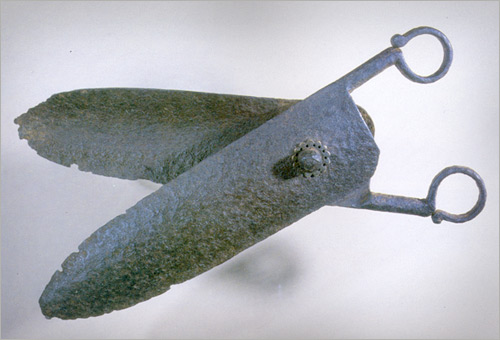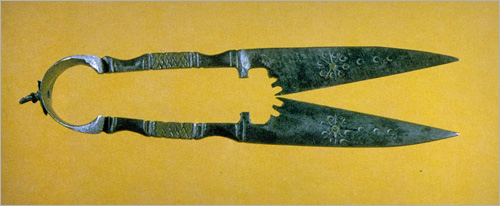
I often wonder why there are so many different kinds of scissors on the market and decided to do a little digging for the history of scissors. All too often the things we use daily are taken for granted. We don’t stop to ask how they first came about or when.
The first known scissor appeared in ancient Egypt around 1500 BC. This was a spring scissor made of two bronze blades connected at the handles by a thin, flexible strip of curved bronze which held the blades in alignment to allow them to be squeezed together, and to pull apart when released.
The Romans adapted the scissor to a pivoted scissor of bronze or iron and these are the direct ancestor of modern scissors. This type scissor was found in China, Japan and Korea and this pivoted concept is still used in almost all modern scissors
Serrated blades are a type of blade used on saws and on some knives or scissors. It has a cutting edge that has many small points of contact with the material being cut. By having less contact area than a smooth blade, the applied force at each point of contact is relatively greater and it prevents the fabric from slipping while cutting.
Pinking Shears as we know them today were first invented and patented in 1893 by Louise Austin of Whatcom, Washington, “to facilitate pinking and scalloping as a marked improvement over ordinary pinking irons and tools.”
And did you know there are cultural superstitions connected to scissors?
AFRICA: In parts of North Africa it was held that scissors could be used to curse a bridegroom. When the bridegroom was on horseback, the person enacting the curse would stand behind him with the scissors open and call his name. If the bridegroom answered to his name being called, the scissors would then be snapped shut and the bridegroom would be unable to consummate his marriage with the bride.
ASIA: In Pakistan, some believed that scissors should never be idly opened and closed without purpose. Doing so is believed to cause bad luck
UNITED STATES: In New Orleans, some believed that putting an open pair of scissors underneath your pillow at night was a sound method for sleeping well, even if one might be cursed.
So keep these things in mind the next time you pick up your scissors!



So much for history. Now, have you seen Clover’s line of scissors? It’s an awsome line and I find I need them all.
Clover’s Patchwork Scissors have blue handles and are serrated. There are 4 different sizes, each with a special purpose.
CUTWORK: This fine pointed tip is perfect for cutting and trimming where accuracy is needed … chenille, quilting, applique, and all sewing and crafts. Heavy duty blades make it easy to cut through several layers of fabric.
SMALL: Perfect for cutting applique pieces …. doesn’t allow the fabric to slip while cutting.

PATCHWORK SCISSOR: Perfect for cutting mulitple layers of fabric . A cover is included for safe and easy handling and storage.
LARGE: Made from top-grade stainless steel, these scissors are sharp and durable while excellent for cutting multiple layers of fabric. These are more in the line of tailor scissors.
—————————————–
ULTIMATE SCISSORS – Oh my, the scissors in this line cut multiple layers of fabric right to the point like cutting butter with a hot knife. Once you cut with them they become a must have item in your sewing room.
EX-135: These are one of my favorite scissors to keep handy while working with my applique and piecework projects.
BENT EX-135B: My second favorite scissor for applique work and machine embroidery as the curved or “bent” blade allows you to clip around curves and on the machine to slip under the presser foot and clip threads.
EX-170: These big guys are excellent for cutting large fabric pieces as in garment construction.
EX-200: Anyone that constructs their own garments will want these beauties on their sewing table. They are excellent for cutting large fabric pieces and multiple layers.
—————————————–
These clippers are the best and I keep them handy when hand quilting and I need to “snip” a thread. If you haven’t had the opportunity to work with them you will be pleasantly surprised at how useful they are … quick snips without getting your fingers caught in the handles of regular scissors. And, Clover’s Clippers are much better looking than the medieval clippers!!